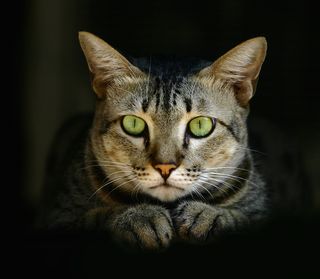
Why Don't People Have Orange or Golden Eyes?

The animal kingdom is full of creatures with wacky-colored peepers: great horned owls sport stunning golden eyes, while cats see through bright green, yellow or even orange eyes. So why don't humans show such colorful oglers?
Actually, these amazing animal eye colors aren't all that different from those of people, said Dr. Mark Fromer, an ophthalmologist at Lenox Hill Hospital in New York City.
When people talk about eye color, they're actually referring to the color of the iris, a ring of muscle (known as a sphincter) within the eye. If the iris contains a lot of melanin, or pigment, then the eye will appear brown, Fromer said. As the amount of melanin decreases, eye color shows up as hazel, green or blue. [Why Do Babies' Eyes Start Out Blue, Then Change Color?]
Animals with unusual eye colors fall on the same color continuum, Fromer said.

"The orange is actually an amber. The golden color is a variation of brown," Fromer said. "They're all variations along a very common line of color, starting from brown [and going] to amber to hazel to green to blue," Fromer told Live Science.
With a few exceptions, such as the red-eyed tree frog, red is usually not included on this color scale. It's a common misconception that individuals who are albino have red eyes. In reality, their irises don't have any pigment, because the gene that controls the production of melanin is completely turned off in albinism. Instead, the red color comes from the blood vessels that support the iris, Fromer said.
When asked about the rumor that actress Elizabeth Taylor (1932-2011) had violet eyes, Fromer said that he's never heard of, or seen, purple eyes. But he mused that it might be possible if a person had light blue eyes and prominent red blood vessels, as blue and red make purple.
Sign up for the Live Science daily newsletter now
Get the world’s most fascinating discoveries delivered straight to your inbox.
Furthermore, he added that eye color might appear to change when a person's eyes dilate or constrict. When an eye is dilated (that is, when the pupil is large so that it can take in more light), the iris is compressed and may look darker because the pigment is crammed into a smaller area.
In contrast, when the eye is constricted, on a bright sunny day, for instance, the pupil shrinks and the iris grows in size. When this happens, the iris's color may look less intense, because the pigment is more spread out, he said.
But regardless of whether an iris is dilated or constricted, it's highly implausible that humans would have the same eye colors as owls or cats have, Fromer said.
"To see such extreme hues would require significant outliers with significantly abnormal colors for humans to find each other and mate," he said. "This, of course, is quite unlikely."
Original article on Live Science.

Laura is the archaeology and Life's Little Mysteries editor at Live Science. She also reports on general science, including paleontology. Her work has appeared in The New York Times, Scholastic, Popular Science and Spectrum, a site on autism research. She has won multiple awards from the Society of Professional Journalists and the Washington Newspaper Publishers Association for her reporting at a weekly newspaper near Seattle. Laura holds a bachelor's degree in English literature and psychology from Washington University in St. Louis and a master's degree in science writing from NYU.
